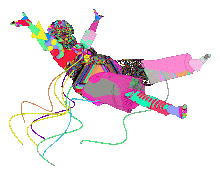THE ORIGINAL SEVEN INTELLIGENCES
info task by ...and you will know us by the trail of dead @ 4/19/2007THE ORIGINAL SEVEN INTELLIGENCES
Howard Gardner first identified and introduced to us seven different kinds of intelligence in Frames of Mind.
• Linguistic intelligence: a sensitivity to the meaning and order of words.
• Logical-mathematical intelligence: ability in mathematics and other complex logical systems.
• Musical intelligence: the ability to understand and create music. Musicians, composers and dancers show a heightened musical intelligence.
• Spatial intelligence: the ability to "think in pictures," to perceive the visual world accurately, and recreate (or alter) it in the mind or on paper. Spatial intelligence is highly developed in artists, architects, designers and sculptors.
• Bodily-kinesthetic intelligence: the ability to use one's body in a skilled way, for self-expression or toward a goal. Mimes, dancers, basketball players, and actors are among those who display bodily-kinesthetic intelligence.
• Interpersonal intelligence: an ability to perceive and understand other individuals -- their moods, desires, and motivations. Political and religious leaders, skilled parents and teachers, and therapists use this intelligence.
• Intrapersonal intelligence: an understanding of one's own emotions.
Some novelists and or counselors use their own experience to guide others. Then, Gardner identified an eighth intelligence, the naturalist intelligence.
HOWARD GARDNER TALKS ABOUT AN EIGHTH INTELLIGENCE
Gardner discussed the "eighth intelligence" with Kathy Checkley, in an interview for Educational Leadership, The First Seven... and the Eighth. Gardner said, "The naturalist intelligence refers to the ability to recognize and classify plants, minerals, and animals, including rocks and grass and all variety of flora and fauna. The ability to recognize cultural artifacts like cars or sneakers may also depend on the naturalist intelligence. …(S)ome people from an early age are extremely good at recognizing and classifying artifacts. For example, we all know kids who, at 3 or 4, are better at recognizing dinosaurs than most adults."
Gardner identified Charles Darwin as a prime example of this type of intelligence. The naturalist intelligence meshed with Gardner's definition of intelligence as "…the human ability to solve problems or to make something that is valued in one or more cultures." And the naturalist intelligence met Gardner's specific criteria: "Is there a particular representation in the brain for the ability? "Are there populations that are especially good or especially impaired in an intelligence? "And, can an evolutionary history of the intelligence be seen in animals other than human beings?"
IMPLEMENTING GARDNER'S THEORY IN THE CLASSROOM
When asked how educators should implement the theory of multiple intelligences, Gardner says, "(I)t's very important that a teacher take individual differences among kids very seriously … The bottom line is a deep interest in children and how their minds are different from one another, and in helping them use their minds well." An awareness of multiple-intelligence theory has stimulated teachers to find more ways of helping all students in their classes. Some schools do this by adapting curriculum.
In "Variations on a Theme: How Teachers Interpret MI Theory," (Educational Leadership, September 1997), Linda Campbell describes five approaches to curriculum change:
• Lesson design. Some schools focus on lesson design. This might involve team teaching ("teachers focusing on their own intelligence strengths"), using all or several of the intelligences in their lessons, or asking student opinions about the best way to teach and learn certain topics.
• Interdisciplinary units. Secondary schools often include interdisciplinary units.
• Student projects. Students can learn to "initiate and manage complex projects" when they are creating student projects.
• Assessments. Assessments are devised which allow students to show what they have learned. Sometimes this takes the form of allowing each student to devise the way he or she will be assessed, while meeting the teacher's criteria for quality.
Apprenticeships. Apprenticeships can allow students to "gain mastery of a valued skill gradually, with effort and discipline over time."
Gardner feels that apprenticeships "…should take up about one-third of a student's schooling experience." With an understanding of Gardner's theory of multiple intelligences, teachers, school administrators, and parents can better understand the learners in their midst. They can allow students to safely explore and learn in many ways, and they can help students direct their own learning. Adults can help students understand and appreciate their strengths, and identify real-world activities that will stimulate more learning.

[b]Estas buscando formas de ganar dinero[/b]
Nosotros hemos hallado la mejor pagina web en internet de como ganar dinero. Como fue de interes para nosotros, tambien les puede ser de utilidad a ustedes. No son unicamente formas de ganar dinero con su pagina web, hay todo tipo de metodos de ganar dinero en internet...
[b][url=http://www.ganar-dinero-ya.com][img]http://www.ganar-dinero-ya.com/dinero.jpg[/img][/url]Te recomendamos entrar a [url=http://www.ganar-dinero-ya.com/]Ganar dinero desde casa[/url][url=http://www.ganar-dinero-ya.com][img]http://www.ganar-dinero-ya.com/dinero.jpg[/img][/url][/b]
- Norman